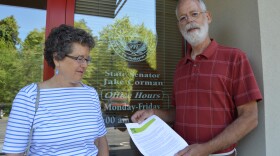Update at noon on Feb. 6, 2019:
Kyle Hynes won first place statewide in the youth division. The Penn State geography class led by Prof. Chris Fowler won first place statewide in the higher education division.
Original Story:
He’s not old enough to cast a ballot, but that hasn’t stopped 15-year-old Kyle Hynes from redrawing the boundaries of Pennsylvania’s 18 congressional districts.
“The fact that I can’t vote actually increases my interest in this because it makes me want to do what I can in this case to ensure that more people have a real say in choosing their representatives,” Hynes said.
Hynes is a State College Area High School sophomore, a goalie for his soccer team and a first-place winner for the central region’s youth division of Draw the Lines PA.
Last January, the Pennsylvania Supreme Court said the state’s congressional districts demonstrated partisan gerrymandering at odds with the state Constitution. The court imposed a new congressional map, but Draw the Lines PA wants to get citizens involved.
“Redistricting is not rocket science," Project Director Chris Satullo said. "Ordinary people who put in the time and are given the right tools can do it.”
Satullo helped create the Draw the Lines PA competition asking participants to redraw congressional districts for the commonwealth. Using a software called District Builder, anyone can draft a map and submit it for a chance to win $500 in the regional competition, and a statewide prize of $4,500.
Satullo said gerrymandering is something that can be fixed, but that change probably won’t come from Harrisburg.
“The maps that have been produced by political leaders are not the result of a lack of skill, or lack of effort," Satullo said. "It’s that their number one goal in drawing maps is the partisan interest of their own team, whether that team is red or blue.”
Satullo said citizens approach mapping with a sense of fairness that politicians just don’t. Most essays submitted with the maps included some definition of fairness as rationale for the district lines.
“People had different definitions, but for everybody, their definition of what’s fair was at the top of their minds while drawing their lines and that’s what makes the difference," Satullo said.
It’s about more than just fairness, though. Maps were judged on four metrics: competitiveness, compactness, equal population distribution and the number of majority-minority districts.
But Pennsylvania’s unique geography, which includes a mix of rural and urban areas, can make it difficult to create competitive districts, according to Elise Lashinsky, a Mercyhurst University senior and first place winner of the central region’s higher education division.
“That balance was hard to get competition in so many districts just because of how Pennsylvania is laid out, so that just made my efforts have to be a lot more,” Lashinsky said.
Lashinsky said that although the shapes of some of her districts might not be compact, they are competitive. She thinks that’s what made her map stand out.
“A lot of the districts are strange shapes, which looks like gerrymandering, but since my efforts weren’t to favor one party over the other, really it’s anti-gerrymandering," Lashinsky said. "So I think that kind of caught their attention.”
Regardless of the shapes the districts took on, Lashinsky echoed the same sentiment as Satullo.
“This is something anyone can do. You don’t really need to be educated in political science to come up with a good map,” Lashinsky said.
Penn State Geography Professor Chris Fowler proved exactly that. Students in his population geography class designed maps as part of a lab assignment. Ultimately, the one they submitted won second place in the central region's higher education division.
“The assignment was essentially to think about what you would want out of your electoral district and then they got to use Draw the Lines to try to enact that,” Fowler said.
Fowler required his students to collect data about what people wanted to see in redistricting efforts. Before last year’s Penn State-Ohio State football game, one of his students, Jake Kaminski, surveyed more than a hundred people who were tailgating.
“It was early in the tailgate," Kaminski joked.
Kidding aside, the results showed that what people want isn’t that hard to articulate.
“When you ask people, and you show them these questions – they were a little lengthy – but when you ask them the simple version of ‘Do you think we should have a competitive election when we vote?’ they’re like 'yes,'” Kamiski said.
Next year’s competition will ask participants to draw 17 districts instead of 18 to account for new census data showing Pennsylvania isn’t growing as fast as other states and will lose one district.
The competition opened last week – and Hynes said he already has a map ready to submit.
“Drawing a 17-district map, I really had to toss the whole thing out and start from scratch, but so far I think I like the result,” Hynes said.
The statewide winner will be recognized at a ceremony Wednesday at the Capitol. To draft your own map using District Builder, visit DrawtheLinesPA.org.







